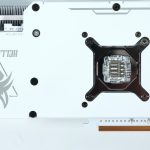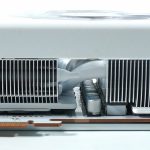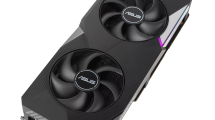AMD took its time with the Navi32, probably also for resource reasons, and now PowerColor even comes with an RX 7800XT Hellhound in a completely white dress – right down to the board and coils. The GeForce RTX 4070 is always firmly in view and of course poses with the 16 GB graphics memory. The cooler is huge, the power limit is ample and the clock rate is just right. And it’s just as quiet as it is bright. I can spoil that in advance. So it’s more than just an object for show.
Important foreword
Of course, as usual, there are lots of benchmarks, the comprehensive teardown, a very elaborate board and cooler analysis with some reverse engineering, a material analysis with my new lab equipment and the analysis of the power consumption and load peaks, including a suitable power supply recommendation. I don’t need to repeat all the technical details and theory, so I’ll save myself a lot of time today and just briefly refer you to the already known slides and the short presentation of the two cards with the most important details. After all, you want to see real figures today and not PR fireworks. We’ve already had that recently.
Navi32 at a glance
AMD’s Navi 32 GPU is produced at TSMC in the 5 nm process (GCD, 5N FinFET) or in the 6 nm process (MCD, N6 FinFET), which in turn indicates an MCM design. A total of 4 chiplets (Navi31 with 6) are located on the now square package and the 346 mm² total area of the interposer is covered by a GCD with around 200 mm² and four MCDs with 36.6 mm² die area. This means that the mid-range has been given the complete Navi32 and even leaves a gap to the significantly slower RX 7600, where a Radeon 7700 without XT or an RX 7600XT would easily fit, as the leap is still far too big. But let’s just wait and see, after all, the price structure still has to consolidate to some extent. The table shows the filled and the still open gap very clearly.
| Radeon RX 7900 XTX |
Radeon RX 7900 XT |
Radeon RX 7900 GRE |
Radeon RX 7800 XT |
Radeon RX 7700 XT |
Radeon RX 7600 |
|
|---|---|---|---|---|---|---|
| Architecture | RDNA 3 | RDNA 3 | RDNA 3 | RDNA 3 | RDNA 3 | RDNA 3 |
| Chip Name | Navi 31 XTX | Navi 31 XT | Navi 31 XL | Navi 32 XT | Navi 32 XL | Navi 33 XL |
| GPU Design | Multi-Chiplet | Multi-Chiplet | Multi-Chiplet | Multi-Chiplet | Multi-Chiplet | Monolith |
| Process Node | TSMC N5 TSMC N6 |
TSMC N5 TSMC N6 |
TSMC N5 TSMC N6 |
TSMC N5 TSMC N6 |
TSMC N5 TSMC N6 |
TSMC N6 |
| Compute Units | 96 | 84 | 80 | 60 | 54 | 32 |
| Shader units | 6.144 | 5.376 | 5.120 | 3.840 | 3.456 | 2.048 |
| RT Accelerators |
96 | 84 | 80 | 60 | 54 | 32 |
| AI Accelerators | 192 | 158 | 160 | 120 | 108 | 64 |
| Memory | 24GB GDDR6 20 GT/s |
20 GB GDDR6 20 GT/s |
16GB GDDR6 18 GT/s |
16GB GDDR6 19.5 GT/s |
12GB GDDR6 18 GT/s |
8GB GDDR6 18 GT/s |
| Interface | 384 bit | 320 bit | 256 bits | 256 bits | 192-bit | 128 bits |
| TBP | 355 W | 315 W | 260 W | 263 W | 245 W | 165 W |
| MSRP | 999 USD | 899 USD | 649 USD | 499 USD | 449 USD | 269 USD |
AMD sees the new cards in direct competition with NVIDIA’s GeForce RTX 4070 and RTX 4060 Ti 16 GB, which can of course also be seen in the slides. We will of course find out for ourselves today where this ends in reality in the benchmarks. For a direct comparison, I have already taken the data from the GPU-Z screenshot
PowerColor RX 7800XT Hellhound Spectral White
With a length of 32.2 cm from the outer edge of the slot bracket to the opposite end of the cooler cover, the 1285 gram card is relatively long. The height of the inserted card is also quite generous at 12.5 cm from the top edge of the PCIe slot to the top edge of the radiator cover. As a 2.5-slot design, it is 4.7 cm thick and requires an additional 0.5 cm at the rear for the backplate. It has a dual BIOS, but this only affects the fans. Small spoiler: The OC BIOS is default and already very quiet.
We see a card with a white light metal shroud and we will soon see from the material analysis that a lot of titanium oxide has been used here. So please don’t lick it! The two outer fans, each with a diameter of 9.7 cm, flank a middle fan with a diameter of 8.7 cm and they all have two things in common: they are transparent with white LED lighting and they all have 9 rotor blades with an outer ring.
On the top side, we primarily see the two 8-pin sockets for the external power supply.
If we look at the slot panel (bracket), we see a tidy variety in full width. With the three DisplayPort 2.1 connections (up to 8K 165 Hz or 4K at 480 Hz) and an HDMI 2.1 socket, you are fully equipped. Unfortunately, there is no longer a USB Type C port (hello VR community!).
- 1 - Introduction and technical data
- 2 - Test system in igor'sLAB MIFCOM-PC
- 3 - Teardown: PCB and components
- 4 - Teardown: Cooler and material analysis
- 5 - Gaming-Performance in Full-HD (1920 x 1080)
- 6 - Gaming-Performance in WQHD (2560 x 1440)
- 7 - Details: power consumption and load balancing
- 8 - Transients and PSU recommendation
- 9 - Clock rates, temperatures and infrared analysis
- 10 - Noise level and fan curves
- 11 - Summary and conclusion




















































145 Antworten
Kommentar
Lade neue Kommentare
Veteran
Urgestein
Urgestein
Urgestein
1
Urgestein
Urgestein
1
Urgestein
Urgestein
Urgestein
Urgestein
Urgestein
Urgestein
1
Urgestein
Urgestein
Urgestein
Urgestein
Alle Kommentare lesen unter igor´sLAB Community →